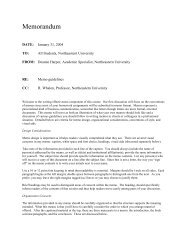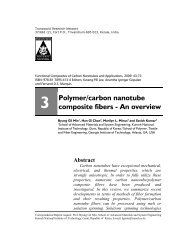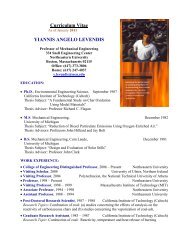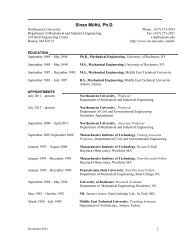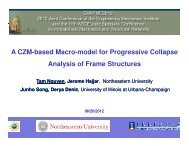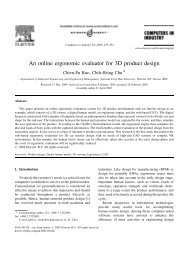Create successful ePaper yourself
Turn your PDF publications into a flip-book with our unique Google optimized e-Paper software.
Notation<br />
As Area of the headed stud anchor<br />
Avg. (µ) Average<br />
Cv Coefficient for shear strengths<br />
C.O.V. Coefficient of variation<br />
Ec Modulus of elasticity of the concrete<br />
Ecm Secant modulus of elasticity of concrete<br />
d Diameter of the headed stud anchor<br />
f ′<br />
c<br />
f<br />
Specified compressive strength of the concrete<br />
′<br />
cr Average measured compressive strength of the<br />
concrete<br />
f ′<br />
c,sp<br />
f<br />
Specified splitting tensile strength of concrete<br />
′<br />
s<br />
Fu<br />
Yield stress of the steel<br />
Specified minimum tensile strength of a stud shear<br />
connector<br />
h Height of the stud<br />
hef Effective embedment depth anchor<br />
kcp Coefficient to compute pryout by ACI 318-08; it<br />
equals 1 for hef < 2.5 <strong>and</strong> 2 for hef ≥ 2.5<br />
Nb Nominal concrete breakout strength of a single<br />
anchor in tension in cracked concrete<br />
P Load applied in the test<br />
Qnv Nominal shear strength of anchor<br />
Qnvc Nominal shear strength in the concrete<br />
Qnvs Nominal shear strength in the steel<br />
Rg, Rp Metal deck coefficients in composite slabs<br />
Rm/Rn Average of the ratios between the test result <strong>and</strong> the<br />
predicted value<br />
St.D. (σ ) St<strong>and</strong>ard deviation<br />
Vcp Concrete pryout strength of a single anchor in shear<br />
VR Coefficient of variation of resistance<br />
VF Coefficient of variation on fabrication<br />
VP Coefficient of variation of Rm/Rn<br />
VM Coefficient of variation of materials<br />
α Linearization approximation constant used to separate<br />
the resistance <strong>and</strong> dem<strong>and</strong> uncertainties<br />
β Reliability index<br />
λ Modification factor for lightweight concrete<br />
ξ Reduction factor for cyclic loading<br />
φv Resistance factor for shear strength<br />
In the figures<br />
• Steel failure in test<br />
◦ Concrete failure in test<br />
× Mixed failure in test<br />
Ollgaard et al. [15] proposed the first formula adopted by the<br />
AISC Manual in 1993 to compute the shear strength of headed studs<br />
(see Table 1). They tested 48 push-out tests in lightweight <strong>and</strong><br />
normal-weight concrete with an effective embedment depth ratio,<br />
hef /d, of 3.26. Failures were noted in both the steel <strong>and</strong> concrete<br />
material.<br />
Oehlers <strong>and</strong> Bradford [16] indicate that short studs experimentally<br />
show a lower shear strength than long steel stud anchors. The<br />
variation in the shear strength with height has been recognized<br />
in some national st<strong>and</strong>ards. For example, the British St<strong>and</strong>ards for<br />
bridges (e.g., [17]) have given the strength of 19 × 100 mm steel<br />
stud anchors as 14%–18% stronger than 19 × 75 mm steel stud<br />
anchors depending on the strength of the concrete. Furthermore,<br />
[18], as a result of a finite element analysis, pointed out the rapid<br />
increase in strength with the height of the steel anchor. These authors<br />
noted that at a ratio of 7 between the height <strong>and</strong> the diam-<br />
L. Pallarés, J.F. <strong>Hajjar</strong> / Journal of Constructional Steel Research 66 (2010) 198–212 199<br />
Table 1<br />
Proposed equations for headed steel anchor strength in composite structures.<br />
Author Equation a<br />
Viest (1956) [7] If d < 1 in, then Qnv = 5.25d 2 f ′<br />
�<br />
4000<br />
c f ′<br />
c<br />
If d > 1 in, then Qnv = 5df ′<br />
�<br />
4000<br />
c<br />
Driscoll <strong>and</strong> Slutter (1961) [8] Long studs (h/d > 4.2): Qnv = 932d2√f ′<br />
c<br />
As<br />
Short studs (h/d < 4.2): Qnv = 222hd<br />
Buttry (1965), Baldwin et al.<br />
√<br />
f<br />
′<br />
c<br />
As<br />
Steel failure: Qnvs = Asf ′<br />
(1965), Dallam (1968) [22–24]<br />
s<br />
Concrete failure:<br />
Qnvc = 0.0157hdf ′<br />
Ollgaard et al. (1971) [15]<br />
c,sp + 6.80<br />
�<br />
Qnvs = 0.5As f ′<br />
c<br />
Ec < AsFu<br />
a Units: pounds, inches for [7]; Units: kips, inches for [8,23,22,24,15].<br />
eter of the shank, the strength is 98% of the maximum attainable<br />
strength.<br />
The AISC Specification has included provisions for composite<br />
structures since 1936. Tables providing allowable horizontal shear<br />
load of headed studs as a function of the stud diameter <strong>and</strong><br />
concrete strength appeared in the AISC Specification of 1961<br />
[19]. The effects of a metal deck on the shear strength of the<br />
headed studs were added in 1978 [20] <strong>and</strong> the AISC Specification<br />
adopted Ollgaard’s formula [15] to compute the shear strength of<br />
headed steel studs in 1993 [21]. In Europe, codifying provisions<br />
for composite construction as part of Eurocode (EC) culminated<br />
with an initial version of the provisions being issued in the 1990’s,<br />
followed by issuing of Eurocode-4 (2004) more recently.<br />
Composite beams, specifically hot-rolled steel shapes with a<br />
concrete floor slab either with or without metal deck formwork,<br />
have received extensive coverage in the literature (e.g., [8,22–29])<br />
<strong>and</strong> are not within the scope of this paper.<br />
This paper reviews 391 monotonic <strong>and</strong> cyclic tests from the<br />
literature on experiments of headed stud anchors <strong>and</strong> proposes<br />
formulas for the limit states of steel failure <strong>and</strong> concrete failure<br />
of headed stud anchors subjected to shear force without the use<br />
of a metal deck. Detailing provisions to prevent premature pryout<br />
failure are also discussed. This paper also reviews proposals<br />
from several authors <strong>and</strong> provides recommended shear strength<br />
values for the cyclic seismic behavior of headed studs. The limit<br />
state formulas are proposed within the context of the AISC Specification<br />
[30,31] <strong>and</strong> EC-4 (2004) [32], <strong>and</strong> comparisons are made to<br />
the provisions in the ACI 318-08 Building Code [2] <strong>and</strong> the PCI H<strong>and</strong>book,<br />
6th Edition [6]. The scope of this research includes composite<br />
beam–columns [typically concrete-encased steel shapes (SRCs) or<br />
concrete-filled steel tubes (CFTs)], concrete-encased <strong>and</strong> concretefilled<br />
beams, boundary elements of composite wall systems, composite<br />
connections, composite column base conditions, <strong>and</strong> related<br />
forms of composite construction. Pallarés <strong>and</strong> <strong>Hajjar</strong> [33] cover the<br />
response of steel stud anchors subjected to tension force <strong>and</strong> combined<br />
tension <strong>and</strong> shear.<br />
This paper also reviews cyclic tests under high-amplitude<br />
loading simulating seismic excitation. Hawkins <strong>and</strong> Mitchell [34],<br />
Gattesco <strong>and</strong> Giuriani [35], Bursi <strong>and</strong> Gramola [36], Z<strong>and</strong>onini<br />
<strong>and</strong> Bursi [37], <strong>and</strong> Civjan <strong>and</strong> Singh [38] performed a range of<br />
different types of push–pull tests on headed steel studs under<br />
high amplitude cyclic shear loading for slabs in composite beams.<br />
Saari et al. [39] reported the headed stud anchor behavior of<br />
partially-restrained steel frames with reinforced concrete infill<br />
walls, looking at both static <strong>and</strong> cyclic loads. Saari et al. [39] studied<br />
shear, tension, <strong>and</strong> shear/tension interaction response for headed<br />
studs with two types of confining reinforcing patterns. These tests<br />
showed that if sufficient confinement is included, concrete failure<br />
is precluded.<br />
2. Objectives<br />
This paper reports on the behavior of headed studs embedded<br />
in solid concrete slabs subjected to shear force, including both<br />
f ′<br />
c



